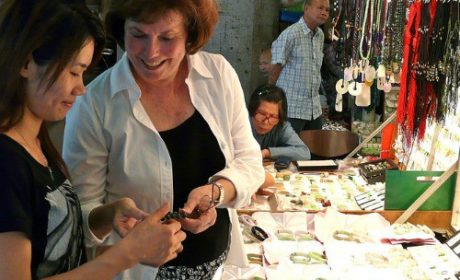Anyone who knows me will will tell you that I am not a shopper. While I enjoy writing and photographing my boomer travel experiences, finding bargains or just the right trinket to bring home is not one of my strong points. That’s why I’m pleased that Brette Sember has agreed to write a two-part series on travel shopping including how to find and buy unique and beautiful treasures while traveling. In today’s installment, she talks about how to plan your shopping and how to know where to go for the best stores.

Hiking, kayaking, snorkeling, touring, and tasting are all high on my list of travel adventures, but if I’m honest, my favorite activity while traveling is shopping. When at home, I shop only for necessities: grocery store, discount stores, drug stores, and clothes/shoes stores when necessary. But when I travel, I am transformed into Super Shopper. I tirelessly hunt down special, unique, and beautiful artisan-made items (and a few fun, tacky souvenirs) that allow me to bring my travels home with me. Not only do I thrive on the thrill of the hunt, but I love to live in a home that has mementoes of places I visited. I’m not interested in outlet malls or designer clothing stores when I travel. That kind of merchandise can be found at my own local outlet mall or online. I want items that I will never see anywhere else in the world. Over the years, I’ve become a bit of an expert in the art of travel shopping.
Research Before You Go Travel Shopping
Before you pack your bags and head out, do some research to find out what items to look for on your trip. What is the area known for? What do they grow there (like lemons on the Amalfi Coast of Italy), traditionally make (such as sweet grass baskets in the Low Country of South Carolina), or naturally have in abundance (like wild blueberries in Maine)? What crafts or techniques have become local specialties (such as quilting in Hawaii)? Often standard guidebooks like Frommer’s or Fodor’s will have a short (usually too short!) section about shopping and briefly mention these specialties if you can find them. You can also do a Google search or search sites like TripAdvisor for discussions about shopping in your location. If you arrive unsure about what to look for, ask your hotel concierge or desk clerk for some tips about what people often buy in the area.

Have Collections
While I always find out the special items made in the area when shopping, I also always have an eye out to add to my collections while I am traveling. I collect bookmarks, sheep, Christmas ornaments, handmade baskets, glass, Easter eggs, watercolor paintings of places we visited, and magnets. Having a collection gives you something to look for and a reason to shop. It’s also a nice way to build a group of items that represent your travels all in one place. My handmade baskets include sweet grass from the Low Country, a lightship basket from Nantucket, a pine needle basket from Florida, one with bone from Alaska, and straw from a pueblo, and each speaks to me of the special place it came from.
I highly recommend starting a fun, cheap collection of something you can easily find at tacky souvenir shops. I collect magnets from every location we visit. My mom collects pens. Other people buy shot glasses, thimbles, baseball caps, or even postcards. These items are easy to find in any souvenir shop, particularly if you have a really short time period for shopping (such as in cruise ship ports), and this allows you to bring something home no matter what.
It can also be fun to buy things that you can use up at home, such as soaps or candles (scented with something local), packaged food products (pasta from Italy, scone mix from England, buffalo jerky from the American west), or even small things like locally produced lip balm. Jam and jelly are very common items that are locally made in almost every location. These types of items won’t clutter your home and will give you a chance to relive the flavors of your trip.
Plan to Shop for Gifts
Think about your holiday gift list before you travel. Keep this in mind while on the road. If you see items that are simply perfect for special people on your list, snap them up. Also keep in mind that you can buy many gifts to use as hostess gifts, for hard-to-buy-for people, and those last minute gifting situations. Unique and special items you brought home from a trip send a message that you were thinking of the recipient even while traveling, and are usually gratefully received.

Find the Good Stores
Finding shops with artisan-made items is harder than you might think. If you are in a big city, you will have to know where you’re going: you won’t find these shops by merely wandering. For example, if you visited Vancouver, you could walk for blocks in the main section of the city and find nothing, because the good shopping is sequestered on Granville Island! If you visit a city that has free tourist guides, look through these. Artisan shops often advertise in these guides. Your concierge can also point in the right direction. And be sure to ask your social media friends where to shop as well—you probably know someone, or know someone who knows someone who lives there or has been there.
Once you find one shop, there are likely to be others in the neighborhood, so wander a bit . Don’t be afraid to walk into shops that have huge displays of cheap t-shirts and souvenirs. Sometimes you will find hidden gems inside them—I have stumbled upon great artisan items in corners of unexpected stores.
Here are some places you should definitely pop into:
- Grocery stores. These are fun to go in because they give you insight into the people and culture of the area. If you’re in a foreign country, you’ll see labels in different languages. The produce section will also be different in other countries. It’s an excellent place to actually shop: t-shirts, packaged candy, postcards, local food products you can take home, and sometimes even locally made housewares, toys, and more.
- Museum shops. You don’t have to pay to go into the museum to get into the shop. Historical museums and art galleries often carry handmade crafts and art from the area that you won’t find anywhere else. If there are any living history museums in the area be sure to visit their shops since they often sell crafts actually made in the museum by talented demonstrators. (You can also ask at the store where to find locally made items).
- Squares, piazzas, or other gathering points for tourists, particularly in the evenings. Artists often sell their goods at these spots.
- Artist’s cooperatives. These shops carry a large array of items from many local artists. Usually the artists take turns staffing the shop. They are good sources of information about where to find items you are still looking for as well.
- Nearby towns identified as art hotspots. For example, when we visited Sedona, Arizona, we made a side trip to the town of Jerome, which is known mainly for its artisan shopping and galleries. Always read about nearby towns to find out if they might be a shopping mecca.
Do you have tips for travel shopping? Join the conversation at the My Itchy Travel Feet page on Facebook or send us an email to ask a question or share your experience.
Be sure to check back for part two of this series. Brette will offer advice about how to shop wisely and get your treasures home safely.



